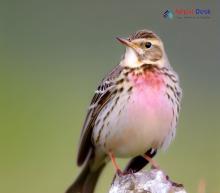Exploring the World of Anthus: A Closer Look at Nepal's Diverse Bird Species
The Anthus, a genus belonging to the Passeridae family, is known for its diverse bird species that can be found across the globe. Among the many regions where these fascinating creatures reside, Nepal stands out as a notable habitat for Anthus birds. Here, we'll delve into the classification, common features, evolutionary relationships, and nomenclature of Anthus species in Nepal.
Classification and Common Features
Nepal's rich biodiversity has much to offer both ornithologists and bird enthusiasts alike. The Anthus genus is no exception, with several species calling this Himalayan country home. These birds typically inhabit grasslands, meadows, and marshes. Some common features found among the Anthus species in Nepal include their medium size, brownish or buff upper parts with streaks or spots, slender bill, and distinct white belly.
Evolutionary Relationships
Anthus birds are closely related to other passerines such as larks and pipits. They share numerous similarities in morphology, behavior, and ecology. Researchers have discovered through mitochondrial DNA studies that there might be two separate lineages within the Anthus genus. This suggests a more complex evolutionary history than previously thought.
Nomenclature and Species Found in Nepal
When it comes to naming conventions for the Anthus genus in Nepal, one must consider factors such as regional dialects and classifications used by locals. Additionally, scientific names are given based on Latin or Greek roots to help facilitate communication about species among researchers worldwide.
Some notable Anthus species found in Nepal include:
1. Paddyfield Pipit (Anthus rufulus) - This bird is abundant in cultivated areas near water sources such as rice paddies.
2. Tree Pipit (Anthus trivialis) - This migratory species breeds in Europe and winters in Nepal, where it can be found in forested habitats.
3. Rosy Pipit (Anthus roseatus) - This high-altitude species is generally found in alpine meadows and is famous for its stunning pinkish hue.
In conclusion, the Anthus genus forms an integral part of Nepal's avian diversity. By understanding their classification, common features, and evolutionary relationships, bird lovers and ornithologists alike can appreciate the remarkable characteristics these species bring to Nepal's ecosystem. Be sure to keep an eye out for these fascinating winged wonders during your next trip to this majestic land!




